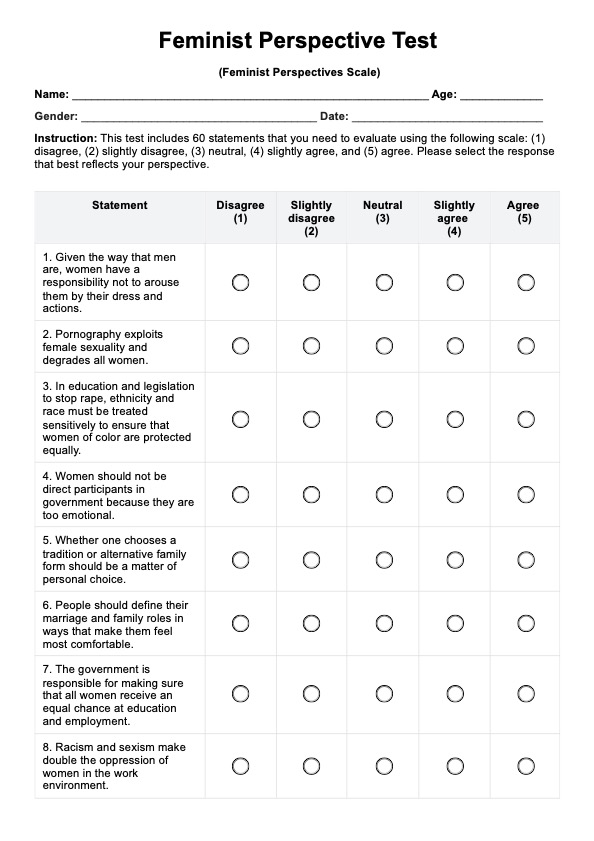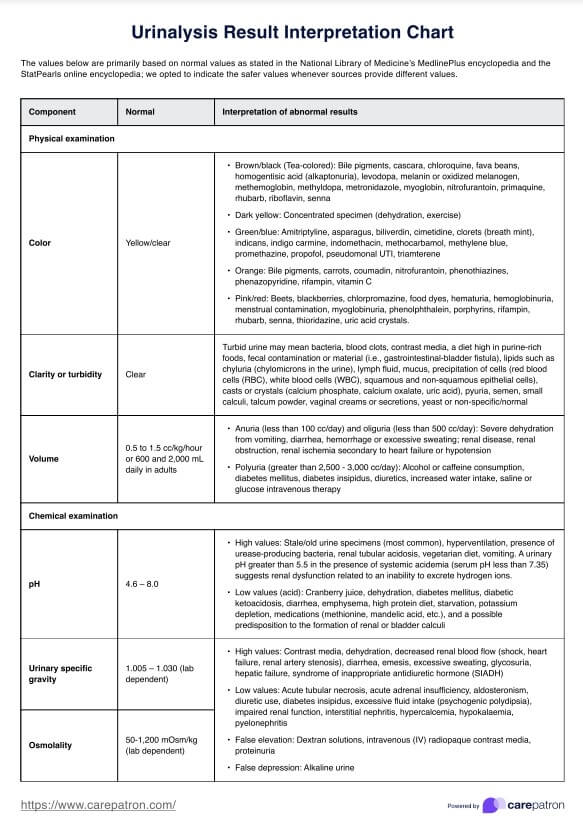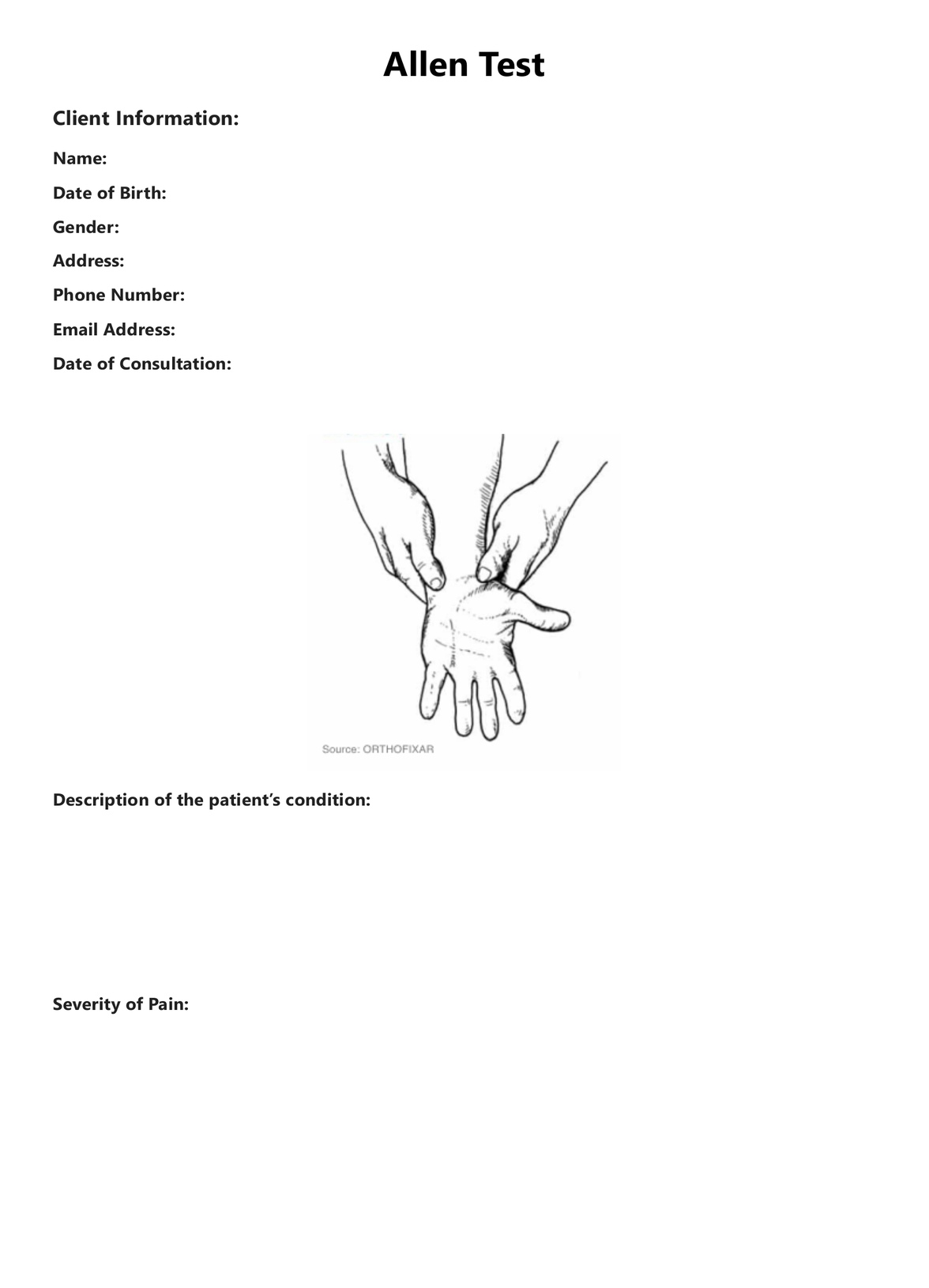High Protein Diet
Learn how to optimize your health with our High Protein Diet Chart: Master weight management and muscle growth with our comprehensive free PDF.


What is a High Protein Diet Chart?
A High Protein Diet Chart is a nutritional tool designed to guide individuals looking to increase their protein intake, often for specific health or fitness goals. This chart type is particularly useful for those aiming to build muscle, lose weight, or improve overall athletic performance, as well as for people who need higher protein levels for health reasons.
The chart lists a variety of protein-rich foods, categorized by their source, such as animal-based proteins (meat, poultry, fish, dairy, eggs) and plant-based proteins (legumes, nuts, seeds, tofu). It provides an at-a-glance view of the protein content in different foods, helping users make informed choices about what to include in their meals.
In addition to listing protein sources, our High Protein Diet Chart offers general guidelines on portion sizes and the frequency of protein consumption to meet specific health goals. This feature is particularly useful for adapting high-protein diets to various dietary needs and preferences, including vegetarian or vegan lifestyles.
A High Protein Diet Chart can be a part of a broader nutritional plan. It's a resource that can be used both for short-term dietary adjustments and for long-term lifestyle changes, depending on the individual's health and fitness goals.
High Protein Diet Template
High Protein Diet Example
How to Utilize the Printable High Protein Diet Chart Template?
Our template provides a comprehensive approach to a high protein diet, including pointers on how to best integrate into a vegetarian and low carb diet plan. Capitalizing on this low carb diet plan template can augment your practice and advance client results.
To ensure you make the most of this tool, we've crafted a detailed step-by-step guide on using our High Protein Diet chart. Just follow these straightforward steps to maximize the benefits.
Step 1: Download and Print the Chart
Start by downloading the Printable High Protein Diet Chart. It's typically available in a PDF format, making it easy to print and use as a physical guide.
Step 2: Understand and Plan Your Diet
Review the chart to understand the variety of high-protein foods listed, both from animal and plant sources. Use this information to plan your meals, keeping your health goals and dietary preferences in mind.
Step 3: Customize and Incorporate into Your Routine
Tailor your meal plans according to your specific dietary needs, such as vegetarian or vegan preferences. Incorporate these meals into your daily routine, adjusting as needed based on your progress and dietary response.
Step 4: Balance with Other Nutrients
Ensure your diet is well-rounded by balancing protein intake with other essential nutrients like carbohydrates, fats, vitamins, and minerals for overall health and wellness.
By following these streamlined steps, the Printable High Protein Diet Chart becomes an effective tool to guide you toward your health and fitness goals through a structured and balanced diet.
When Would You Use This Chart?
Our high-protein diet chart is a versatile tool that can be used by a wide range of individuals for various purposes, from improving general health to supporting athletic performance, recovery from illness, and effective dietary planning.
General Health Improvement
For those looking to enhance their overall health and nutrition, this chart provides a comprehensive guide on how much protein they should aim to consume based on their body weight. It's especially useful for individuals starting a high-protein diet to improve their health.
Athletes and Active Individuals
This chart is ideal for athletes and those who lead a physically active lifestyle. It outlines the increased protein needs required for muscle repair, growth, and recovery after exercise. This makes it an essential tool for anyone involved in sports or regular physical training.
Recovery or Illness
During periods of recovery from illness or injury, the body's protein needs may increase. This chart would be particularly useful for individuals in these situations, helping them to adjust their diet to meet their heightened nutritional requirements.
Dietary Planning and Education
The template is a valuable educational tool for dietitians, nutritionists, or anyone involved in dietary planning. It provides detailed information on various animal and plant-based protein sources and their respective protein contents, aiding in the creation of balanced and nutritious meal plans.
Vegetarians and Vegan
This chart offers information on plant-based protein sources for those who do not consume animal products. It's an essential guide for vegetarians and vegans to ensure they get enough protein from various sources.
Efficacy of High Protein Diets
A high protein diet offers several potential benefits, which can contribute to overall health and well-being. These benefits include:
Weight Loss
High protein diets can aid in weight loss. Proteins tend to make people feel fuller on fewer calories, leading to reduced food intake. This effect, combined with a low carbohydrate intake, can result in significant weight loss, although results may vary based on factors like overall calorie consumption and physical activity levels (Willoughby, D., Hewlings, S., & Kalman, D., 2018).
Improved Body Composition
High protein diets can positively influence body composition, which is the ratio of fat to muscle, bone, and water in the body. Increased protein intake can lead to a higher muscle mass and reduced body fat, leading to a healthier body composition (Stokes et al., 2018).
Enhanced Recovery
Protein contributes to faster recovery post-exercise by reducing muscle damage and promoting muscle repair. This is especially beneficial after intense or prolonged workouts or recovery from an injury (Stokes et al., 2018).
Performance Improvement
High protein intake is linked to improved muscle strength and endurance, which can enhance overall athletic performance. This is due to the role of protein in maintaining and building lean muscle mass.
Prevention of Muscle Loss
In athletes or older adults, a high-protein diet helps prevent muscle loss while promoting fat loss (Moon & Koh, 2020).
Things to Keep in Mind
Here are a few things to remember before starting a high-protein diet:
- It’s essential to ensure that your diet is diverse, while you can prioritize protein it is important to Include a variety of nutrients such as fiber, vitamins, and minerals for overall health.
- Be mindful of your protein sources. High intake, especially from sources rich in saturated fats, can burden the kidneys and impact heart health.
- Often neglected in high protein diets, fiber is vital. Adequate fiber consumption is necessary to prevent digestive issues like constipation.
- Be mindful of portion sizes to avoid excessive calorie intake, which can counteract weight loss efforts.
- Excessive dietary limitations or over-concentration on protein can lead to health complications. Adhere to recommended quantities and diversify your diet.
- Ensure that your high protein diet is sustainable in the long term. Drastic or restrictive diets are often difficult to maintain and may lead to nutrient deficiencies.
- If adverse effects arise while following the diet, consulting a healthcare professional is crucial.
- Those with existing health conditions, older adults, pregnant women, or individuals planning the diet for children should particularly seek professional advice.
- A healthcare provider can customize the diet to your specific health requirements and goals, ensuring both safety and effectiveness.
References
Willoughby, D., Hewlings, S., & Kalman, D. (2018). Body Composition Changes in Weight Loss: Strategies and Supplementation for Maintaining Lean Body Mass, a Brief Review. Nutrients, 10(12), 1876. https://doi.org/10.3390/nu10121876
Stokes, T., Hector, A. J., Morton, R. W., McGlory, C., & Phillips, S. M. (2018). Recent Perspectives Regarding the Role of Dietary Protein for the Promotion of Muscle Hypertrophy with Resistance Exercise Training. Nutrients, 10(2), 180. https://doi.org/10.3390/nu10020180
Moon, J., & Koh, G. (2020). Clinical Evidence and Mechanisms of High-Protein Diet-Induced Weight Loss. Journal of obesity & metabolic syndrome, 29(3), 166–173. https://doi.org/10.7570/jomes20028
U.S. Department of Agriculture. (2023). FoodData Central. Retrieved November 13, 2023, from https://fdc.nal.usda.gov/
Commonly asked questions
High Protein Diet Charts are commonly requested by a diverse group of individuals, each with their own unique reasons for seeking such a diet plan as athletes, bodybuilders, people looking to lose weight, and vegetarians.
These charts are used during fitness programs, weight management programs, medical recovery, and nutritional education and planning.
The duration of using a high-protein diet chart varies based on individual goals and needs. It's important to note that the duration should be tailored to individual health needs and goals, and seeking advice from a nutritionist or healthcare provider is often recommended.


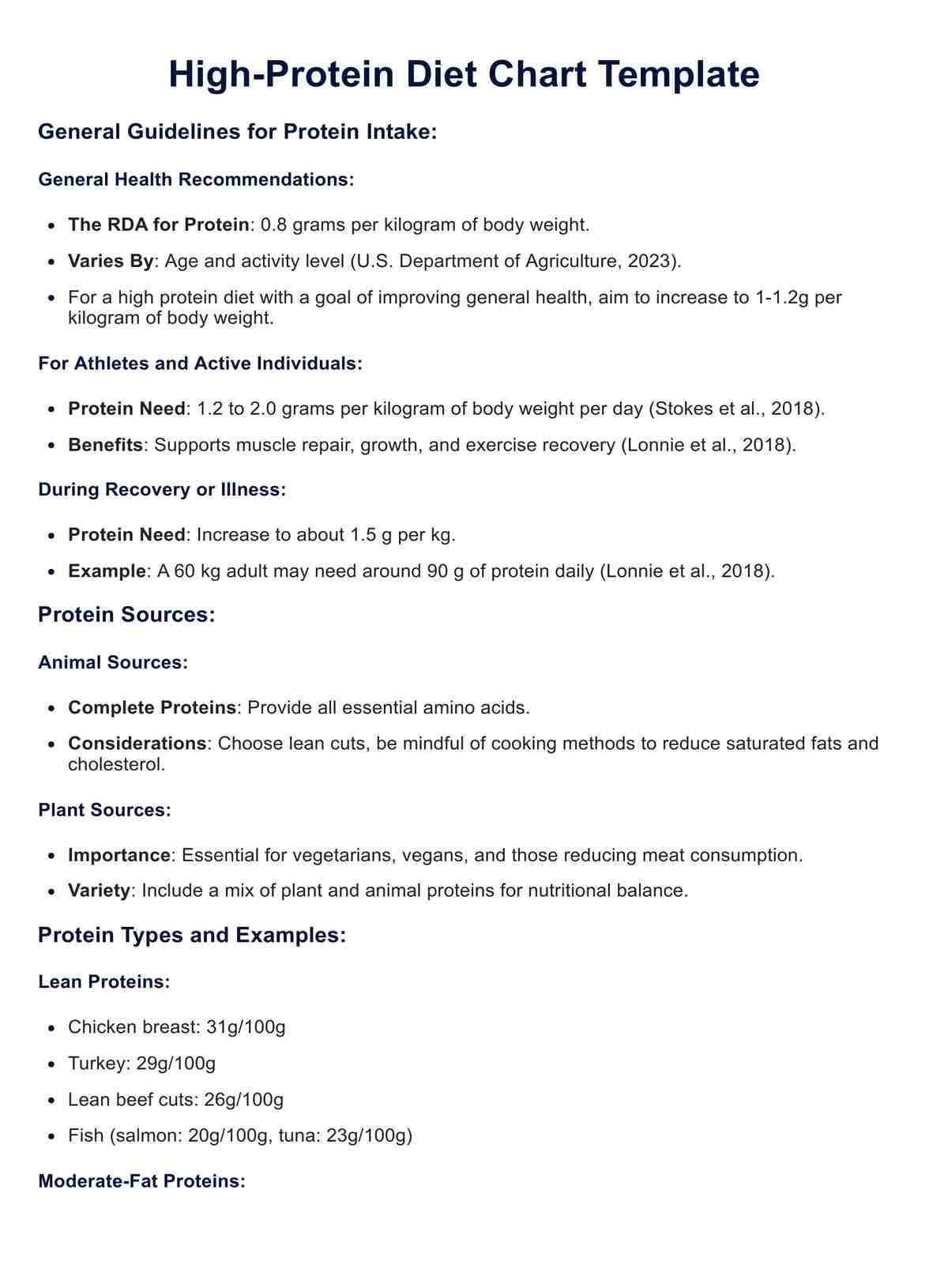
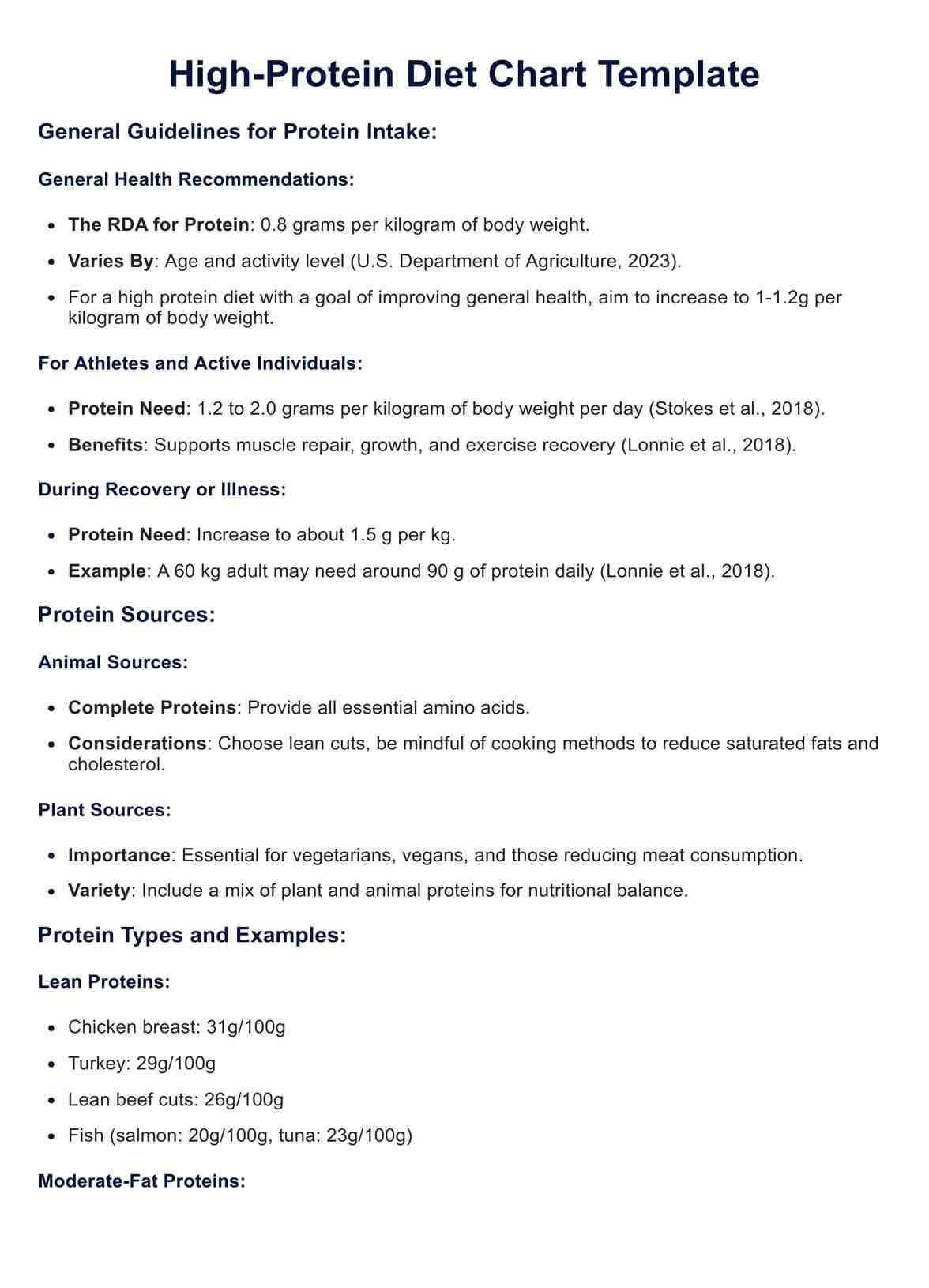

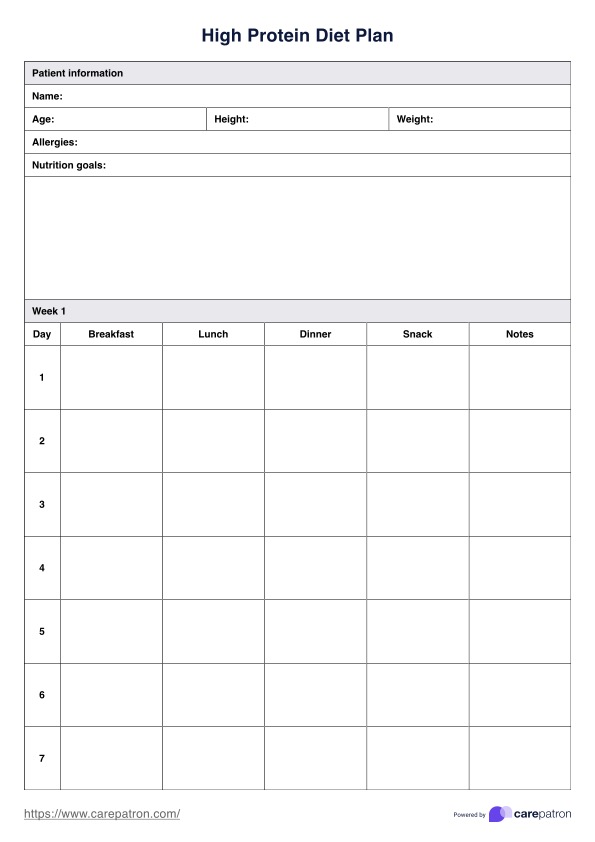
















-template.jpg)
















































































